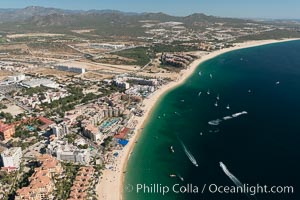
Aerial view of Medano Beach in Cabo San Lucas, showing many resorts along the long white sand beach.
Location: Cabo San Lucas, Baja California, Mexico
Image ID: 28883
Location: Cabo San Lucas, Baja California, Mexico
Image ID: 28883
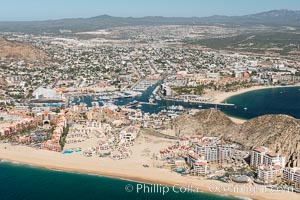
Cabo San Lucas, marina and downtown, showing extensive development and many resorts and sport fishing boats.
Location: Cabo San Lucas, Baja California, Mexico
Image ID: 28889
Location: Cabo San Lucas, Baja California, Mexico
Image ID: 28889
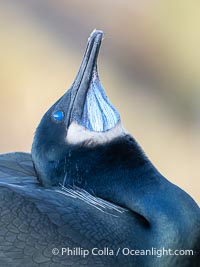
Male Brandt's Cormorant Skypointing, Courtship Display, Breeding Plumage with blue throat and white pin-feathers, La Jolla. Skypointing is an interesting courtship behavior that many birds practice. Among Brandt's Cormorants the male performs this, likely as a way of attracting a mate to the nest he has built by showing off his striking blue throat. He tips his head backward showing off his striking blue throat, and partially raises his wings. Seen here on seacliffs above the ocean.
Species: Brandt's cormorant, Phalacrocorax penicillatus
Location: La Jolla, California
Image ID: 40150
Species: Brandt's cormorant, Phalacrocorax penicillatus
Location: La Jolla, California
Image ID: 40150
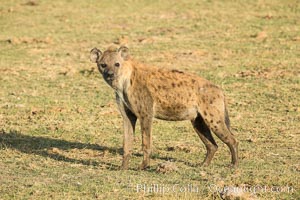
Spotted hyena, Amboseli National Park, Kenya.
Species: Spotted hyena, Crocuta crocuta
Location: Amboseli National Park, Kenya
Image ID: 29522
Species: Spotted hyena, Crocuta crocuta
Location: Amboseli National Park, Kenya
Image ID: 29522
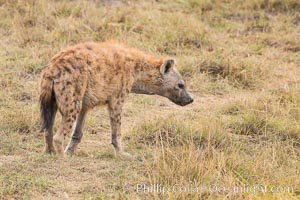
Spotted hyena, Amboseli National Park, Kenya.
Species: Spotted hyena, Crocuta crocuta
Location: Amboseli National Park, Kenya
Image ID: 29582
Species: Spotted hyena, Crocuta crocuta
Location: Amboseli National Park, Kenya
Image ID: 29582
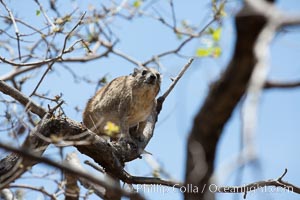
Bush hyrax, or yellow-spotted rock hyrax, Meru National Park, Kenya.
Species: Bush hyrax, Heterohyrax brucei
Location: Meru National Park, Kenya
Image ID: 29725
Species: Bush hyrax, Heterohyrax brucei
Location: Meru National Park, Kenya
Image ID: 29725
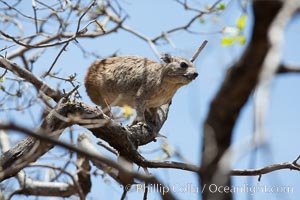
Bush hyrax, or yellow-spotted rock hyrax, Meru National Park, Kenya.
Species: Bush hyrax, Heterohyrax brucei
Location: Meru National Park, Kenya
Image ID: 29726
Species: Bush hyrax, Heterohyrax brucei
Location: Meru National Park, Kenya
Image ID: 29726
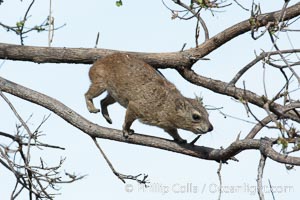
Bush hyrax, or yellow-spotted rock hyrax, Meru National Park, Kenya.
Species: Bush hyrax, Heterohyrax brucei
Location: Meru National Park, Kenya
Image ID: 29745
Species: Bush hyrax, Heterohyrax brucei
Location: Meru National Park, Kenya
Image ID: 29745
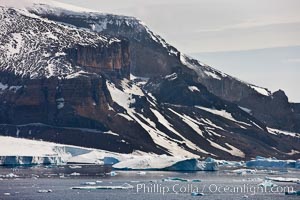
Brown Bluff, the eroded remains of an extinct volcanic structure, below which many penguins and seabirds nest.
Location: Antarctic Sound, Antarctic Peninsula, Antarctica
Image ID: 24809
Location: Antarctic Sound, Antarctic Peninsula, Antarctica
Image ID: 24809
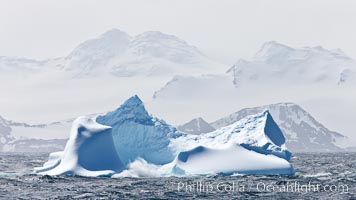
Coronation Island, is the largest of the South Orkney Islands, reaching 4,153' (1,266m) above sea level. While it is largely covered by ice, Coronation Island also is home to some tundra habitat, and is inhabited by many seals, penguins and seabirds.
Location: Coronation Island, South Orkney Islands, Southern Ocean
Image ID: 24849
Location: Coronation Island, South Orkney Islands, Southern Ocean
Image ID: 24849
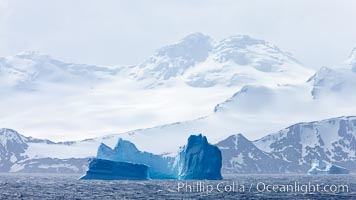
Coronation Island, is the largest of the South Orkney Islands, reaching 4,153' (1,266m) above sea level. While it is largely covered by ice, Coronation Island also is home to some tundra habitat, and is inhabited by many seals, penguins and seabirds.
Location: Coronation Island, South Orkney Islands, Southern Ocean
Image ID: 24850
Location: Coronation Island, South Orkney Islands, Southern Ocean
Image ID: 24850
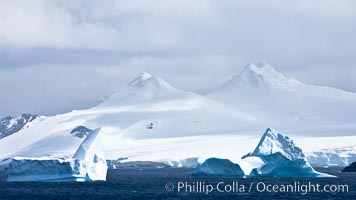
Coronation Island, is the largest of the South Orkney Islands, reaching 4,153' (1,266m) above sea level. While it is largely covered by ice, Coronation Island also is home to some tundra habitat, and is inhabited by many seals, penguins and seabirds.
Location: Coronation Island, South Orkney Islands, Southern Ocean
Image ID: 24851
Location: Coronation Island, South Orkney Islands, Southern Ocean
Image ID: 24851
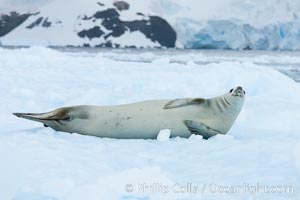
A crabeater seal, hauled out on pack ice to rest. Crabeater seals reach 2m and 200kg in size, with females being slightly larger than males. Crabeaters are the most abundant species of seal in the world, with as many as 75 million individuals. Despite its name, 80% the crabeater seal's diet consists of Antarctic krill. They have specially adapted teeth to strain the small krill from the water.
Species: Crabeater seal, Lobodon carcinophagus
Location: Cierva Cove, Antarctic Peninsula, Antarctica
Image ID: 25576
Species: Crabeater seal, Lobodon carcinophagus
Location: Cierva Cove, Antarctic Peninsula, Antarctica
Image ID: 25576
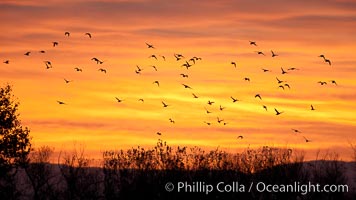
Snow geese in flight at sunrise. Bosque del Apache NWR is winter home to many thousands of snow geese which are often see in vast flocks in the sky.
Species: Snow goose, Chen caerulescens
Location: Bosque Del Apache, Socorro, New Mexico
Image ID: 26219
Species: Snow goose, Chen caerulescens
Location: Bosque Del Apache, Socorro, New Mexico
Image ID: 26219
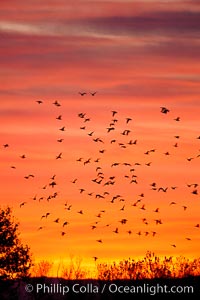
Snow geese in flight at sunrise. Bosque del Apache NWR is winter home to many thousands of snow geese which are often see in vast flocks in the sky.
Species: Snow goose, Chen caerulescens
Location: Bosque Del Apache, Socorro, New Mexico
Image ID: 26232
Species: Snow goose, Chen caerulescens
Location: Bosque Del Apache, Socorro, New Mexico
Image ID: 26232
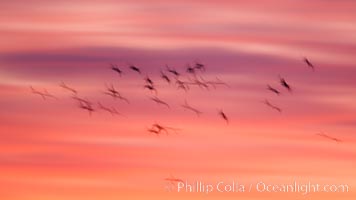
Snow geese in flight at sunrise. Bosque del Apache NWR is winter home to many thousands of snow geese which are often see in vast flocks in the sky.
Species: Snow goose, Chen caerulescens
Location: Bosque Del Apache, Socorro, New Mexico
Image ID: 26252
Species: Snow goose, Chen caerulescens
Location: Bosque Del Apache, Socorro, New Mexico
Image ID: 26252
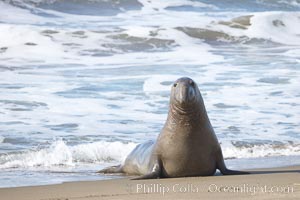
Bull elephant seal exits the water to retake his position on the beach. He shows considerable scarring on his chest and proboscis from many winters fighting other males for territory and rights to a harem of females. Sandy beach rookery, winter, Central California.
Species: Elephant seal, Mirounga angustirostris
Location: Piedras Blancas, San Simeon, California
Image ID: 20394
Species: Elephant seal, Mirounga angustirostris
Location: Piedras Blancas, San Simeon, California
Image ID: 20394
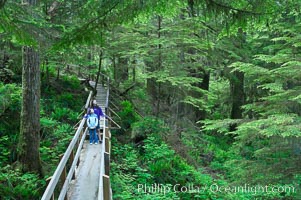
Hikers admire the temperate rainforest along the Rainforest Trail in Pacific Rim NP, one of the best places along the Pacific Coast to experience an old-growth rain forest, complete with western hemlock, red cedar and amabilis fir trees. Moss gardens hang from tree crevices, forming a base for many ferns and conifer seedlings.
Location: Rainforest Trail, Pacific Rim National Park, British Columbia, Canada
Image ID: 21056
Location: Rainforest Trail, Pacific Rim National Park, British Columbia, Canada
Image ID: 21056
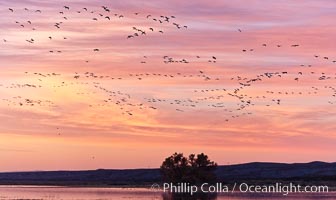
Snow geese in flight at sunrise. Bosque del Apache NWR is winter home to many thousands of snow geese which are often see in vast flocks in the sky.
Species: Snow goose, Chen caerulescens
Location: Bosque Del Apache, Socorro, New Mexico
Image ID: 26210
Species: Snow goose, Chen caerulescens
Location: Bosque Del Apache, Socorro, New Mexico
Image ID: 26210
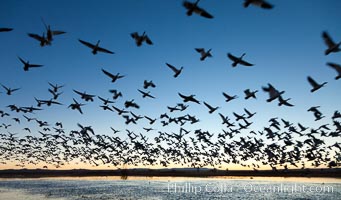
Snow geese in flight at sunrise. Bosque del Apache NWR is winter home to many thousands of snow geese which are often see in vast flocks in the sky.
Species: Snow goose, Chen caerulescens
Location: Bosque Del Apache, Socorro, New Mexico
Image ID: 26198
Species: Snow goose, Chen caerulescens
Location: Bosque Del Apache, Socorro, New Mexico
Image ID: 26198
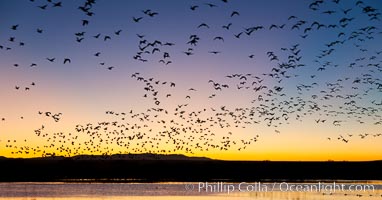
Snow geese in flight at sunrise. Bosque del Apache NWR is winter home to many thousands of snow geese which are often see in vast flocks in the sky.
Species: Snow goose, Chen caerulescens
Location: Bosque Del Apache, Socorro, New Mexico
Image ID: 26201
Species: Snow goose, Chen caerulescens
Location: Bosque Del Apache, Socorro, New Mexico
Image ID: 26201
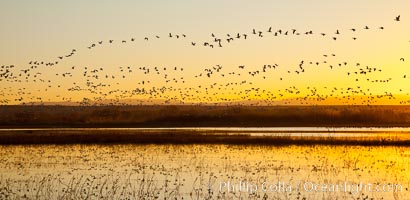
Snow geese in flight at sunrise. Bosque del Apache NWR is winter home to many thousands of snow geese which are often see in vast flocks in the sky.
Species: Snow goose, Chen caerulescens
Location: Bosque Del Apache, Socorro, New Mexico
Image ID: 26223
Species: Snow goose, Chen caerulescens
Location: Bosque Del Apache, Socorro, New Mexico
Image ID: 26223
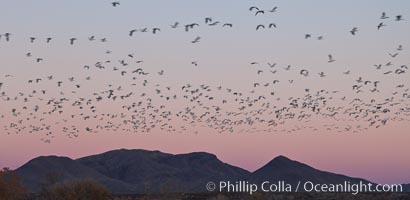
Snow geese in flight at sunrise. Bosque del Apache NWR is winter home to many thousands of snow geese which are often see in vast flocks in the sky.
Species: Snow goose, Chen caerulescens
Location: Bosque Del Apache, Socorro, New Mexico
Image ID: 26236
Species: Snow goose, Chen caerulescens
Location: Bosque Del Apache, Socorro, New Mexico
Image ID: 26236
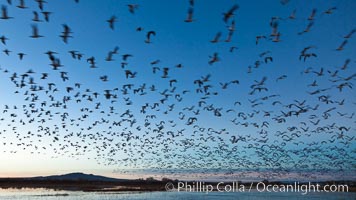
Snow geese in flight at sunrise. Bosque del Apache NWR is winter home to many thousands of snow geese which are often see in vast flocks in the sky.
Species: Snow goose, Chen caerulescens
Location: Bosque Del Apache, Socorro, New Mexico
Image ID: 26237
Species: Snow goose, Chen caerulescens
Location: Bosque Del Apache, Socorro, New Mexico
Image ID: 26237
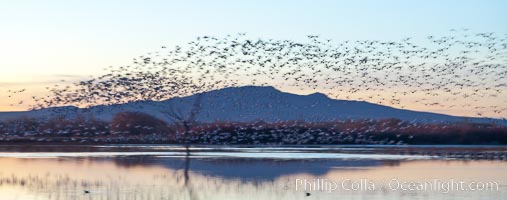
Snow geese in flight at sunrise. Bosque del Apache NWR is winter home to many thousands of snow geese which are often see in vast flocks in the sky.
Species: Snow goose, Chen caerulescens
Location: Bosque Del Apache, Socorro, New Mexico
Image ID: 26238
Species: Snow goose, Chen caerulescens
Location: Bosque Del Apache, Socorro, New Mexico
Image ID: 26238
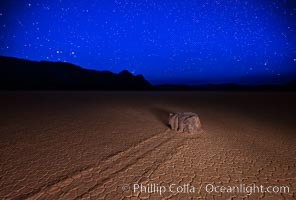
Racetrack sailing stone and stars at night. A sliding rock of the Racetrack Playa. The sliding rocks, or sailing stones, move across the mud flats of the Racetrack Playa, leaving trails behind in the mud. The explanation for their movement is not known with certainty, but many believe wind pushes the rocks over wet and perhaps icy mud in winter.
Location: Racetrack Playa, Death Valley National Park, California
Image ID: 27636
Location: Racetrack Playa, Death Valley National Park, California
Image ID: 27636
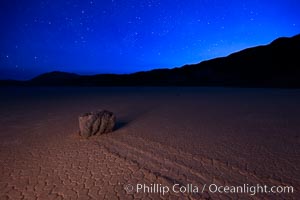
Racetrack sailing stone and stars at night. A sliding rock of the Racetrack Playa. The sliding rocks, or sailing stones, move across the mud flats of the Racetrack Playa, leaving trails behind in the mud. The explanation for their movement is not known with certainty, but many believe wind pushes the rocks over wet and perhaps icy mud in winter.
Location: Racetrack Playa, Death Valley National Park, California
Image ID: 27637
Location: Racetrack Playa, Death Valley National Park, California
Image ID: 27637
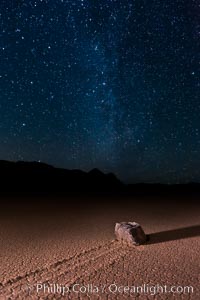
Racetrack sailing stone and Milky Way, at night. A sliding rock of the Racetrack Playa. The sliding rocks, or sailing stones, move across the mud flats of the Racetrack Playa, leaving trails behind in the mud. The explanation for their movement is not known with certainty, but many believe wind pushes the rocks over wet and perhaps icy mud in winter.
Location: Racetrack Playa, Death Valley National Park, California
Image ID: 27638
Location: Racetrack Playa, Death Valley National Park, California
Image ID: 27638
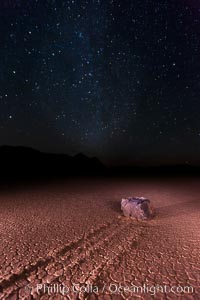
Racetrack sailing stone and Milky Way, at night. A sliding rock of the Racetrack Playa. The sliding rocks, or sailing stones, move across the mud flats of the Racetrack Playa, leaving trails behind in the mud. The explanation for their movement is not known with certainty, but many believe wind pushes the rocks over wet and perhaps icy mud in winter.
Location: Racetrack Playa, Death Valley National Park, California
Image ID: 27639
Location: Racetrack Playa, Death Valley National Park, California
Image ID: 27639
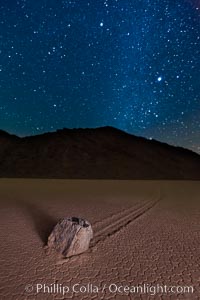
Racetrack sailing stone and Milky Way, at night. A sliding rock of the Racetrack Playa. The sliding rocks, or sailing stones, move across the mud flats of the Racetrack Playa, leaving trails behind in the mud. The explanation for their movement is not known with certainty, but many believe wind pushes the rocks over wet and perhaps icy mud in winter.
Location: Racetrack Playa, Death Valley National Park, California
Image ID: 27641
Location: Racetrack Playa, Death Valley National Park, California
Image ID: 27641